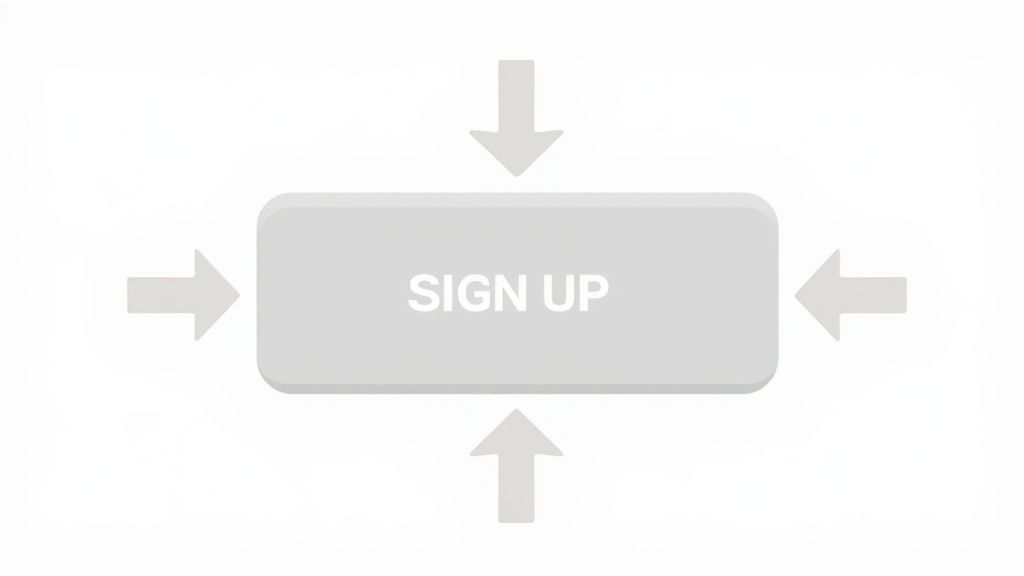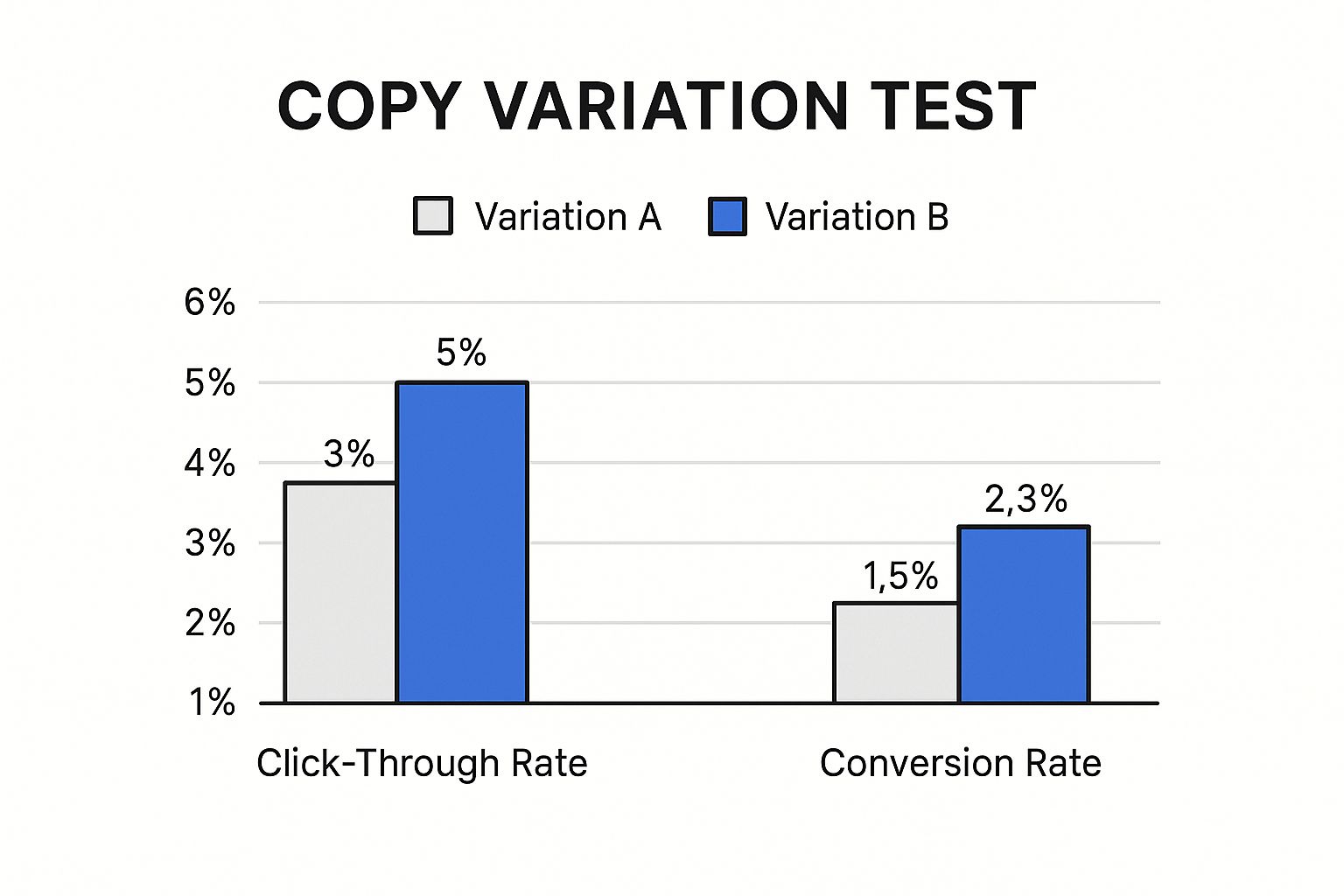When we talk about business copywriting, we’re not just talking about writing pretty sentences. It’s the art and science of using words to get people to do something specific—whether that’s generating leads, boosting sales, or creating die-hard brand loyalty. This isn’t just creative flair; it’s a critical business driver.
What Really Matters in Business Copywriting

Great business copy does more than just fill a blank page. It’s engineered to get a specific result. Before you even think about a headline, you need to change your perspective from “writing” to “building.” You’re building a bridge from a customer’s problem to your solution, and every single word is a plank in that bridge.
This way of thinking is more important now than ever. The demand for copywriters who can deliver real, measurable results is skyrocketing. It’s no surprise the global copywriting market is expected to jump from USD 29.28 billion in 2025 to almost USD 48.89 billion by 2032.
To get a piece of that action, you need to master the fundamentals. Every successful copywriting project, whether it’s an email, a landing page, or a social media ad, rests on a few core pillars.
Core Pillars of Business Copywriting
This table breaks down the fundamental elements required for any successful business copywriting project.
| Pillar | Objective | Key Actions |
|---|---|---|
| Clear Purpose | Define the single most important action you want the reader to take. | Identify one primary goal (e.g., sign-up, purchase, download). |
| Audience Insight | Understand the reader’s pains, desires, and language on a deep level. | Create detailed customer personas, research forums, and read reviews. |
| Compelling Offer | Present your solution in a way that is irresistible to your audience. | Highlight unique value, address objections, and create urgency. |
| Persuasive Structure | Guide the reader logically and emotionally from hook to call-to-action. | Use proven formulas like AIDA or PAS; ensure a smooth flow. |
These pillars aren’t just a checklist; they are the strategic foundation that separates copy that converts from copy that gets ignored.
Define Your Purpose Before You Write a Word
The biggest mistake I see businesses make is jumping straight into writing without a clear goal. “We need a new blog post” isn’t a strategy. The real question you must answer first is: What do I want someone to do after reading this?
Every single piece of copy needs one primary job. Is it to:
- Get a visitor to sign up for a free trial?
- Convince a prospect to book a demo?
- Drive downloads for your latest guide?
- Push a direct sale on your e-commerce site?
Nailing this down first gives you a North Star. It shapes your tone, your key arguments, and your final call to action. With a clear goal, every sentence you write has a purpose.
Your copy is your 24/7 salesperson. If it doesn’t have a clear objective and a compelling pitch, it’s just taking up space. Purposeful writing is what separates content from commerce.
Go Deeper Than Just Demographics
Knowing your audience’s age and zip code is just scratching the surface. Truly powerful business copy comes from a much deeper, more empathetic understanding of the people you’re trying to connect with. You need to get into their heads and understand their real-world frustrations, their secret hopes, and what truly motivates them.
For instance, don’t just target “small business owners.” Get specific. Talk to “Sarah, a 45-year-old marketing manager who’s drowning in data and just wants a simple way to show her boss that her campaigns are working.”
When you get this detailed, you can use the exact words she uses to describe her problems. That’s when she feels seen, heard, and understood. This deep customer insight is also crucial for getting your marketing and sales teams on the same page, since they’ll both be speaking the same language to the same person. For more on this, check out these proven tactics for marketing and sales alignment.
This is the foundation. It’s what allows you to write copy that doesn’t just inform, but truly connects and, most importantly, converts.
Mastering Audience Research and Customer Empathy

Here’s a hard truth about business copywriting: you can’t persuade people you don’t understand. It’s that simple. Before you even think about writing a headline, you have to get inside your audience’s head. This isn’t about making educated guesses; it’s about doing the detective work to build genuine empathy between your brand and your customers.
The real goal here is to stop talking at your audience and start speaking with them. When your copy mirrors the thoughts already running through their minds, you create an instant connection that feels authentic and builds trust.
Finding the Voice of the Customer
The most powerful copy isn’t written; it’s discovered. Your audience is constantly dropping clues about their biggest problems, their deepest desires, and what they actually care about. You just have to know where to look.
This process is what we call Voice of Customer (VoC) research, and it’s your secret weapon. Instead of trying to invent clever taglines, you’ll be borrowing the exact words and phrases your customers already use.
Here are the goldmines where this language is hiding in plain sight:
- Customer Reviews: Start with your own product reviews, then move on to your competitors’. Look for patterns in what people praise and, more importantly, what they complain about. What words do they use to describe their frustrations?
- Online Forums & Communities: Dive into places like Reddit, Quora, and niche Facebook groups. People here aren’t holding back. They’re asking questions and sharing unfiltered opinions about the very problems your business exists to solve.
- Sales & Support Team Chats: Your own frontline teams are an untapped resource. They talk to customers all day long and have a gut-level understanding of common objections, frequently asked questions, and the “aha!” moments that close a deal. Grab a coffee with them and just listen.
Empathy isn’t some fluffy, “soft skill” in copywriting; it’s a strategic advantage. When you can describe a customer’s problem better than they can, they’ll instinctively trust that you have the solution.
Turning Research into a Practical Buyer Persona
Once you’ve collected all this raw feedback, you need to shape it into something you can actually use. That’s where a buyer persona comes in. A persona is a character sketch of your ideal customer, built from real data and research. It’s more than just a list of demographics; it’s a living document that brings your audience to life.
A well-crafted persona ensures you’re always writing for a specific person, not a faceless mob. This focus makes your copy sharper, more personal, and far more likely to hit the mark.

This example shows how scattered data points come together to form a clear profile, giving a writer something tangible to work with.
But let’s get beyond the basics and build a persona that actually drives results.
Key Parts of a Truly Actionable Persona
- Goals & Motivations: What’s their end game? What’s the real driver behind their search? For example, they might want to “prove marketing ROI to their boss to get a promotion.”
- Frustrations & Pain Points: What’s getting in their way? What keeps them up at night? Use direct quotes from your research. Something like, “I’m sick of spending hours building reports that nobody even reads.”
- Watering Holes: Where do they hang out online? What blogs do they read, podcasts do they listen to, and who do they follow on social media? This tells you where to find them and who you’re competing against for their attention.
- The Before & After: Paint a picture of their world before they find your solution, then show how it improves after. This transformation is the story at the heart of all great copy.
By building out these elements, you create a North Star for your writing. Every time you sit down to work, you can ask yourself, “Would [Persona Name] care about this?” This simple gut-check keeps your business copywriting focused, empathetic, and consistently effective.
Writing Words That Actually Convert

Alright, you’ve done the hard work of figuring out who you’re talking to. Now for the fun part: turning those insights into words that get people to act. This is where the rubber meets the road in copywriting for businesses. We’re moving from research to results, crafting messages that drive clicks, calls, and sales.
The secret isn’t about being a literary genius. It’s about using proven copywriting formulas—not as strict rules, but as reliable roadmaps. They help you structure your pitch in a way that just clicks with your ideal customer, both logically and emotionally.
The FAB Framework: From Features to “What’s In It For Me?”
One of the most common traps businesses fall into is listing product features. Your customers don’t care about your product’s specs; they care about what those specs do for them. The Features-Advantages-Benefits (FAB) framework is your best tool to break this habit.
- Feature: What your product has or is. It’s a dry fact. (e.g., “Our software uses 256-bit encryption.”)
- Advantage: What that feature does. (e.g., “This keeps your data secure.”)
- Benefit: Why the customer should care. How does it make their life better? (e.g., “So you can relax knowing your sensitive client data is locked down tight and safe from hackers.”)
The benefit is where the magic happens. It’s the emotional payoff. Remember, nobody buys a drill because they want a drill; they buy it because they want a hole in the wall.
Let’s apply this to a project management tool.
- Before (All Features): “Our platform has Gantt charts and real-time task tracking.”
- After (Benefit-Driven): “Stop wondering where your projects really stand. Our visual timeline gives you a bird’s-eye view, and real-time updates let you spot bottlenecks before they derail your deadlines. You’ll keep every project on track and every client happy.”
See the difference? The “after” version speaks directly to a manager’s biggest fears: uncertainty and unhappy clients.
The PAS Formula: Hitting the Pain Point
The Problem-Agitate-Solution (PAS) formula is incredibly effective because it’s built on a fundamental human truth: people are more motivated to avoid pain than to gain pleasure. It’s a simple, powerful story in three acts.
- Problem: Nail the core frustration your audience is dealing with.
- Agitate: Don’t just state the problem—poke it. Describe why it’s so annoying, frustrating, or costly. Make them feel the sting.
- Solution: Ride in on a white horse and introduce your product as the obvious, easy fix.
People will do almost anything to move away from a problem. PAS uses this psychological trigger to build an urgent need for what you’re selling.
Imagine you’re writing copy for a financial planner who helps freelancers.
Problem: “Tired of the freelance feast-or-famine rollercoaster?”
Agitate: “One month you’re on top of the world, the next you’re staring at your bank account, wondering how you’ll cover next month’s bills. That constant stress makes it impossible to plan ahead, invest in your business, or even take a day off without feeling guilty.”
Solution: “Our financial planning service is built specifically for freelancers like you. We’ll help you smooth out your income, build a cash buffer, and finally get the financial stability you need to thrive.”
This structure is a killer for landing pages, ads, and emails because it cuts right to the chase.
The AIDA Model: Your Customer’s Journey in Four Steps
AIDA is a classic for a reason. Standing for Attention, Interest, Desire, and Action, it maps out the entire journey from “Who are you?” to “Take my money!” It’s perfect for longer pieces of copy like sales pages.
- Attention: Your headline and first sentence. Its only job is to stop the scroll. A surprising stat, a bold claim, or a question that hits close to home works perfectly.
- Interest: Now that you have their attention, hold it. Use short, punchy paragraphs and bullet points to show you understand their problem and have a way to solve it.
- Desire: This is where you crank up the heat, turning their interest into a real want. Use testimonials, case studies, and paint a vivid picture of the “after” state. Show them how much better their life will be.
- Action: Be direct. Tell them exactly what to do next with a strong call-to-action (CTA). Don’t use a limp word like “Submit.” Use an action-oriented phrase like “Start My Free Trial” or “Get Your Custom Quote Now.”
By using these frameworks, you stop just talking about your business and start having a persuasive conversation with your customers. A few small tweaks, guided by these proven structures, can make a huge difference in your results.
Blending SEO and Persuasion for Digital Success
I’ve seen a lot of businesses fall into the trap of thinking they have to choose: write for search engines or write for people. It’s a false choice. Truly great copywriting for businesses doesn’t see these as separate tasks; it weaves them together into a single, cohesive strategy.
Think of it this way: SEO isn’t some rigid set of technical rules you have to follow. It’s a treasure map, drawn from real-world data, that shows you exactly how your customers are looking for solutions. Persuasive copy is the vehicle you build to pick them up and bring them right to your front door. When you get both right, your content doesn’t just get found—it gets results.
This isn’t about awkwardly jamming keywords into robotic sentences. It’s about using those keywords as a compass to guide you toward creating a natural, compelling story that answers a real person’s question with genuine expertise.
Look Beyond Keywords to User Intent
The real secret to modern SEO copywriting is understanding user intent. This is the why behind every single search. When someone types “best project management software for remote teams,” they aren’t just hunting for a feature list. They’re probably feeling the very real pain of missed deadlines, disorganized communication, and a frustrating lack of oversight.
Your job is to meet that person right where they are. Don’t just list what your software does. Speak directly to their problem: “Tired of projects slipping through the cracks now that your team is spread out? Here’s how you can get everyone back on the same page.” This approach works beautifully because it satisfies both Google—which sees you’re directly answering the query—and the human on the other end, who finally feels understood.
Here’s how to put this into practice:
- Analyze the SERPs: Do a search for your main keyword and look at what’s already ranking. Are they how-to guides? Product comparison pages? In-depth articles? This is Google telling you exactly what kind of content best satisfies that specific search.
- Find the Questions: Use a keyword tool to uncover the actual questions people are asking. When you answer these directly in your copy, often with their own subheading, you’re creating incredibly valuable, targeted content.
- Address the Unspoken Need: Go deeper than the literal words. A person searching for a project management tool doesn’t just need software; they need peace of mind. They need more time in their day. They need the confidence that comes from knowing a project is on track. Weave these emotional benefits right into your copy.
Weaving SEO into Your On-Page Copy
Once you have a firm grasp of the user’s intent, you can start strategically placing your keywords into key on-page elements. These act like signposts for both search engines and human readers, guiding them through your content and highlighting the most important information.
Just look at the difference a little persuasion makes. Here’s a comparison of two copy variations and how they performed.

It’s not even close. The more persuasive, benefit-focused copy (Variation B) crushed the generic version. This is hard proof that writing for humans is what actually drives business results.
Balancing these two priorities—technical SEO and human persuasion—is a delicate art. Here’s a quick breakdown of how to think about some key on-page elements.
On-Page SEO vs. Persuasive Copy Elements
| Copy Element | Primary SEO Goal | Primary Persuasion Goal |
|---|---|---|
| Title Tag | Include the primary keyword at the beginning. | Create a compelling headline that promises value and earns the click in search results. |
| Meta Description | Incorporate the keyword and related terms naturally. | Write a mini-ad that summarizes the core benefit and includes a clear call to action. |
| H1 Tag | Use the primary keyword in your main on-page title. | Clearly state what the page is about and hook the reader’s attention immediately. |
| H2/H3 Tags | Use secondary keywords and LSI terms to add context. | Break up content for scannability and guide the reader through your narrative. |
| Image Alt Text | Describe the image using a relevant keyword. | Improve accessibility for all users and provide context if the image doesn’t load. |
The goal is to make all of this feel completely natural. A reader should never be able to spot the “SEO part” of your writing. Every keyword should fit perfectly inside a sentence that’s there to persuade, inform, and connect with your audience.
This synergy is what turns a flood of organic traffic into a steady stream of qualified leads and sales. If you want to dive deeper into tracking those outcomes, our guide on how to measure marketing campaign success is a great next step.
Getting this right is becoming more important every day. By 2025, it’s predicted that digital ad spending will make up over 60% of the entire advertising market, with a huge emphasis on mobile. This means copy has to do more than just build brand awareness; it has to drive measurable action. Businesses are actively looking for writers who can analyze data and tweak their messaging to boost performance, a trend detailed in the full copywriting market report from Mordor Intelligence.
Optimizing and Scaling Your Copywriting Efforts
https://www.youtube.com/embed/7I7vRjB4_SU
Writing great copy is a huge milestone, but it’s really just the beginning. The most successful businesses I’ve seen treat the “publish” button as the starting gun, not the finish line. This is where you switch gears from being a creator to a strategist, turning good words into a finely-tuned growth engine.
To get the most out of your copywriting for businesses, you have to build a continuous feedback loop. It’s a cycle: test your assumptions, measure what’s actually working, and then pour your resources into the winners. This optimization process is what separates brands that plateau from those that see consistent, month-over-month growth.
Test Everything to Find What Truly Works
You might be absolutely convinced that a certain headline is a slam dunk, but the only opinion that matters is your audience’s. This is where A/B testing, or split testing, comes in. It’s a straightforward practice of showing two different versions of your copy to similar audiences to see which one performs better. It’s how you replace guesswork with data.
When you’re starting out, focus on testing one high-impact element at a time. If you change the headline, the CTA, and the body copy all at once, you’ll have no idea which change actually moved the needle.
Here are the best places to start your tests:
- Headlines: This is often the biggest lever you can pull. Pit a benefit-driven headline against one that piques curiosity and see what happens.
- Calls-to-Action (CTAs): Try different button text (“Get Started for Free” vs. “Create Your Account”) or even something as simple as changing the button’s color.
- Body Copy: Test a short, punchy version against a more detailed, long-form explanation. The results might surprise you.
Once you run a test and get a clear winner—let’s say headline B gets a 27% higher click-through rate—that new version becomes your baseline. Now you test something else against it. This cycle of constant improvement is the secret to long-term copywriting success.
Never assume you know what your audience wants. Test your ideas relentlessly. Data-backed insights will always outperform gut feelings, turning your marketing from a gamble into a calculated strategy.
Measure the Metrics That Matter
To know if your copy is truly effective, you have to track the right key performance indicators (KPIs). It’s easy to get distracted by vanity metrics like page views, but they don’t pay the bills. You need to focus on numbers that tie directly back to your business goals.
- Conversion Rate: This is the ultimate test. What percentage of people are taking the action you want them to? Whether it’s signing up, making a purchase, or booking a call, this is your bottom line.
- Click-Through Rate (CTR): For ads, emails, and landing page CTAs, this metric shows you how compelling your copy is at earning that initial click.
- Bounce Rate: If visitors land on your page and leave immediately, it can be a red flag. It often signals a disconnect between your ad or headline and the actual content on the page.
- Time on Page: Are people actually reading your masterpiece? Low time-on-page suggests your copy isn’t holding their attention.
Tracking these numbers gives you a clear report card on your copy’s performance and is a fundamental part of any solid digital marketing for small business strategy.
Scaling Your Content Production
As your business grows, the demand for high-quality copy will grow right along with it. Eventually, one person can’t do it all. You’ll need a plan to scale up your content creation without sacrificing the quality you’ve worked so hard to establish.
You generally have three paths to choose from:
- Hire In-House: This is a great move for companies that need a true brand expert who lives and breathes the company culture every day. It’s a bigger investment upfront but offers unmatched consistency.
- Work with Freelancers: This option provides incredible flexibility. You can tap into specialized expertise for specific projects, like a product launch or a new email sequence.
- Partner with an Agency: Agencies offer a full team and strategic oversight, which is perfect for businesses that want to hand off their entire content function to a dedicated partner.
The right choice really boils down to your budget, your immediate needs, and where you see your company going. Interestingly, industry data reflects this flexible demand. Research on over 500 copywriters found that 59% work freelance, while only 15% are in-house and 20% work at agencies. You can dig into more of these copywriting statistics and findings to see the trends. This breakdown shows that the market is well-equipped to meet diverse business needs, no matter the scale.
Your Copywriting Questions, Answered
It’s totally normal to have questions when you’re diving into copywriting for your business. Everyone does. Whether you’re thinking about bringing in a pro or just want to sharpen your own writing, getting good answers is where it all starts. Let’s tackle some of the most common questions I hear from businesses just like yours.
What’s the Real Difference Between Copywriting and Content Writing?
This one trips a lot of people up, but the distinction is actually pretty simple and incredibly important.
Copywriting is all about getting someone to do something right now. Its sole purpose is persuasion that leads to a specific action—click “Buy Now,” sign up for a demo, or download a guide. Think of the words on your landing pages, in your ads, and throughout your sales emails. It’s direct, action-oriented, and focused on immediate results.
Content writing, on the other hand, plays the long game. The goal here is to inform, educate, or even entertain your audience to build trust and position your brand as the go-to expert. Blog posts, in-depth guides, and case studies are perfect examples. While good content certainly needs to be persuasive, its main job is to build a relationship, not to ask for the sale on the spot.
A smart marketing strategy needs both. They work together, with content warming up your audience and copy closing the deal.
How Much Should We Actually Budget for Copywriting?
There’s no one-size-fits-all price tag, and honestly, you should be wary of anyone who gives you one without knowing your goals. The cost of copywriting depends heavily on the scope of the work, the writer’s level of expertise, and how much that copy can impact your bottom line.
Generally, you’ll see pricing structured in a few ways:
- By the Project: This is a flat fee for a specific deliverable, like a new home page or a 5-part email nurture sequence. It’s clean, predictable, and the most common way to hire a copywriter.
- By the Word: Often used for articles and blog posts. Rates can be anywhere from $0.10 for someone just starting out to over $1.00 per word for a seasoned expert in a technical field like finance or medicine.
- By the Hour: This works best for things like consulting, editing, or ongoing projects where the scope isn’t set in stone. Expect to see rates from $50 to over $250 per hour.
The smartest way to think about this isn’t as a cost, but as an investment. Great copywriting isn’t an expense line on a spreadsheet; it’s a revenue-generating machine. Pinching pennies here usually means leaving a lot more money on the table.
How Do I Know If the Copy Is Actually Working? (Measuring ROI)
This is the most important question of all. If you can’t measure it, you can’t improve it. The trick is to connect the words on the page directly to business goals you can track. Before you even think about launching new copy, make sure your analytics are ready to go.
Your north star metric is almost always the conversion rate. For a product page, that’s the percentage of visitors who buy. For a webinar signup page, it’s the percentage who register. It’s the clearest indicator of whether your copy is doing its job.
Beyond that, keep a close eye on:
- Click-Through Rate (CTR): Are people actually clicking the links in your ads and emails? This tells you if your message is compelling enough to grab their attention.
- A/B Test Results: This is where the magic happens. Pit one headline against another, or one call-to-action against a different version. Seeing a new headline lift conversions by 15% gives you undeniable proof of its value.
- Lead Quality: It’s not just about getting more leads; it’s about getting better ones. Is your sales team reporting that the leads coming from the new copy are more qualified and easier to close?
When you track these numbers, you can draw a straight line from the copy you invested in to the revenue it generated. That’s how you prove the powerful ROI of strategic copywriting.
Ready to stop guessing and start seeing real results from your marketing? The team at ReachLabs.ai combines expert copywriting with data-driven strategy to create messages that convert. Discover how our collective approach can elevate your brand today.





